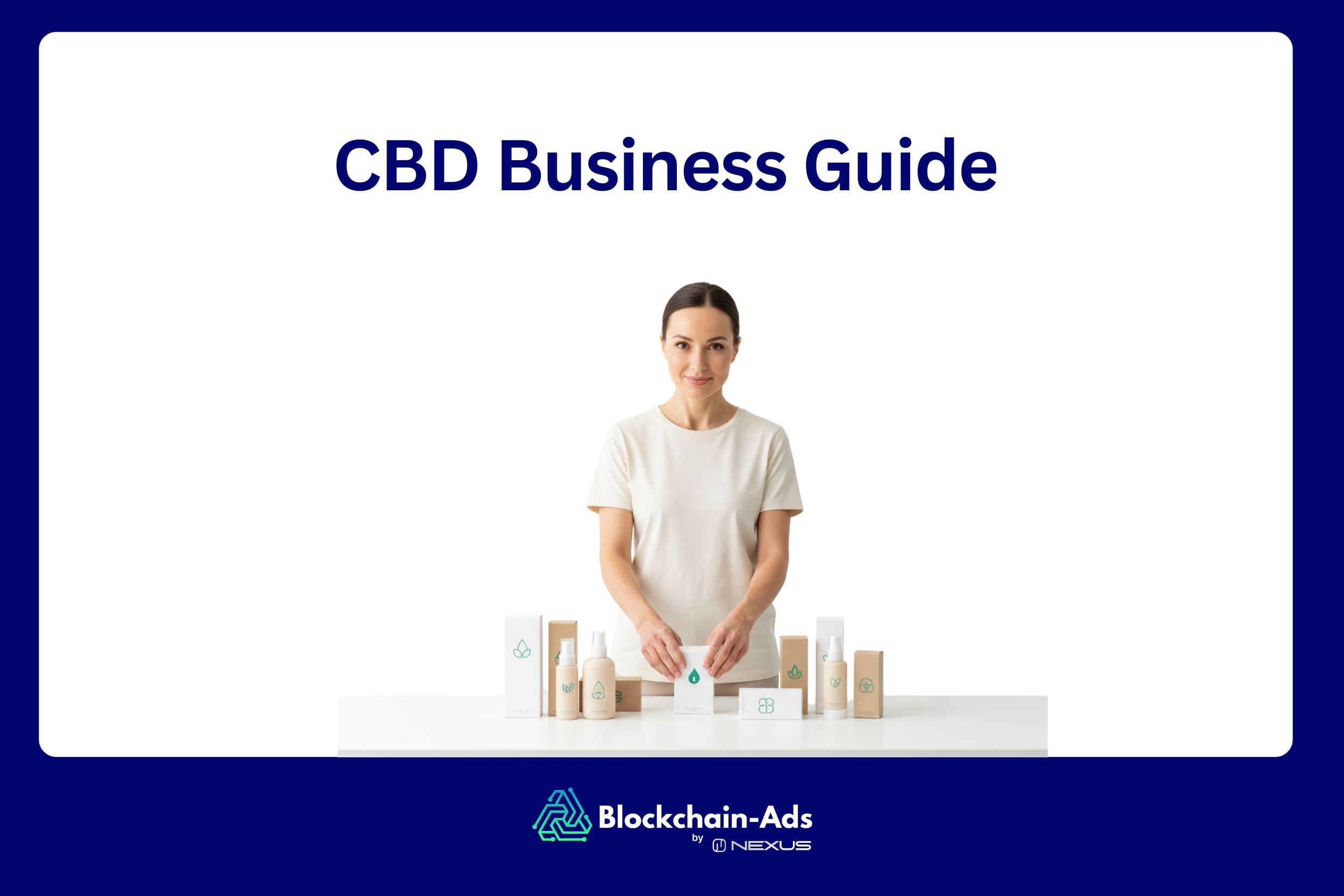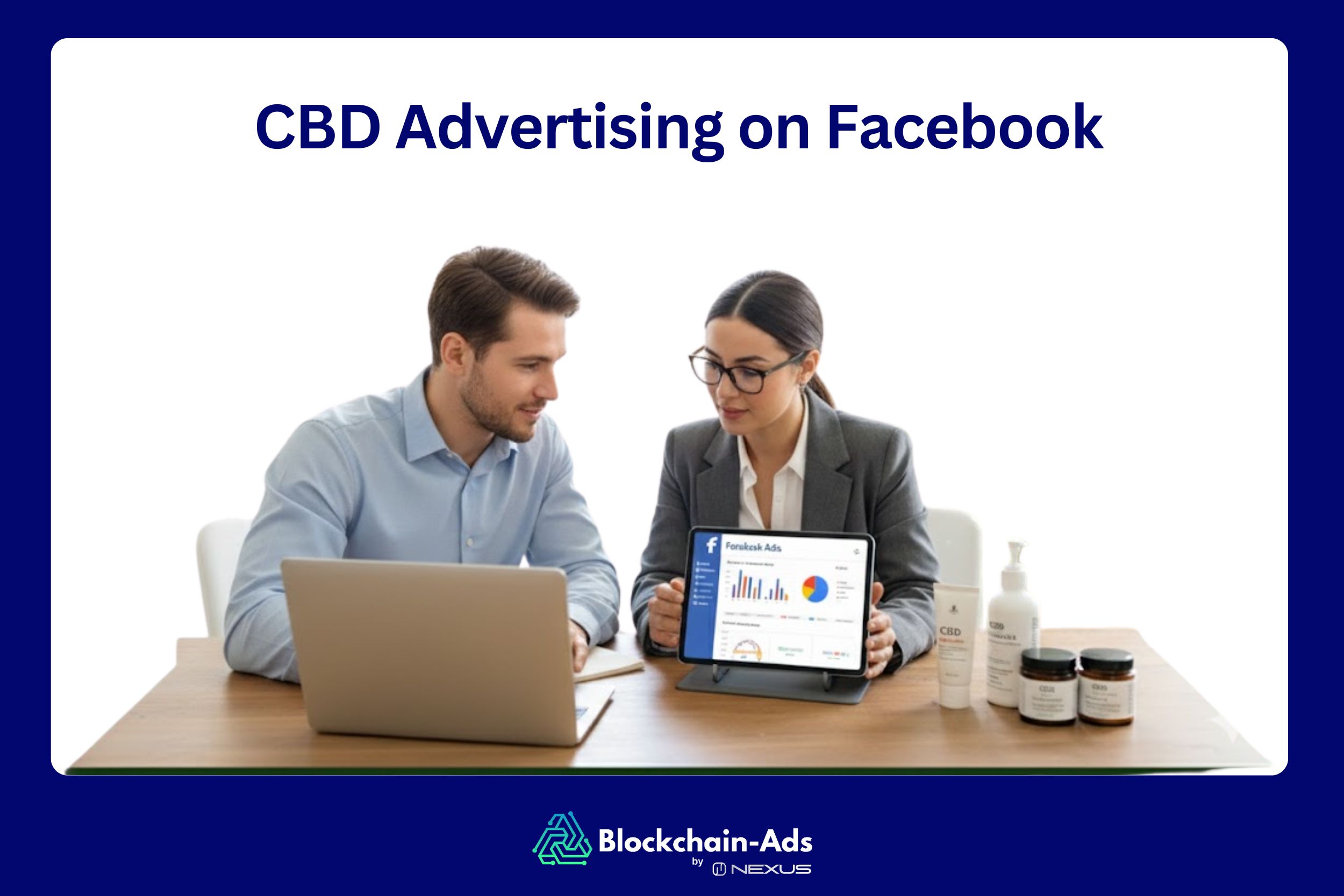How to Start a CBD Business-Step by Step Guide
Heading
- Cointelegraph Formula offers various ad formats to 8 million monthly readers across 190+ countries, leveraging its trusted name in crypto.
Starting a CBD business can be lucrative because most U.S. adults use CBD products for stress relief, better sleep, and pain management. To start a CBD business, you first need to understand the types of CBD and extraction methods because these determine your product quality, legal compliance, and positioning in the market.
Once that’s clear, follow these steps:
- Identify your niche and product line that align with market needs and your brand story
- Create a detailed business plan covering market research, finances, branding, and operations
- Understand and comply with federal and state legal requirements, including labeling and testing
- Secure reliable suppliers who provide quality documentation and certifications
- Build your e-commerce or retail platform with a user-friendly design and compliant payment processing
- Set up logistics for shipping, storage, and insurance that meet CBD-specific regulations
- Develop marketing and sales strategies to connect with your target customers
- Establish trust with certifications, personalization, and quality control
But part where you actually make money is in your marketing and sales strategy. This is where programmatic platforms like Blockchain-Ads help you reach precise, high-intent CBD buyers in a compliant way that drives sales.
This guide provides a step-by-step roadmap to launching your CBD business, covering everything from legal compliance and product sourcing to marketing strategies.
Why Start a CBD Business?
First, it’s actually one of those rare markets that combines fast growth, mainstream acceptance, and genuine impact on people’s lives.
As of 2023, the CBD market was valued at $7.71 billion and forecasts suggest that it could climb to $64.56 billion by 2030. Besides, the average CBD spend per user is $240-$520 per year. This is a clear indication that shows how consumers are currently into wellness, stress relief and natural alternatives.
People are also getting into this business because demand is coming from every direction. Furthermore, 59% consumers are using CBD for relaxation, 55% for stress relief and 51% for better sleep and this makes it a recurring purchase.
There’s also a personal side to it. Many founders enter this space after seeing how CBD helped someone close to them manage anxiety, pain or insomnia. That emotional connection drives authenticity and in this industry, authenticity sells.
Understanding CBD: Types and Extraction
Before starting a CBD business, it’s important to understand what CBD is and how it’s extracted. CBD, or cannabidiol, is one of many compounds naturally found in the Cannabis plant.
However, not all CBD products are the same; the source and extraction process greatly affect quality and legality. Most legal CBD in the U.S. comes from industrial hemp, which contains less than 0.3% THC, the psychoactive compound.
CBD from cannabis plants may have higher THC levels and is subject to stricter state laws. You’ll also encounter different types of CBD products: Full spectrum CBD contains all cannabinoids, terpenes, and a trace of THC (under 0.3%), while CBD isolate is pure CBD without other compounds.
Understanding these differences helps you choose the right products for your business and ensures compliance with regulations.
How to Start CBD Company: Step-by-Step Process
Once you've understood the different CBD types and extractions, follow these steps to launch your CBD business:
Step 1: Identify Your Niche and Product Line
Which products do you want to start selling? Find your niche and product line that aligns with both market demand and your brand story.
For example, you might specialize in stress relief products such as tinctures and gummies for working professionals. Or maybe CBD skincare where customers are looking for plant-based ingredients that soothe inflammation and dryness.
Besides, you may pay attention to minor cannabinoids like CBG and CBN. CBG is basically known for focus and energy whereas CBN is associated with sleep and relaxation.
Step 2: Create a Comprehensive Business Plan
Developing a CBD business plan helps you know where you’re headed. It helps give structure to your vision. In this regard, begin with market analysis. Study the CBD space—Who’s buying, what they’re buying and why. Research your competitors closely. Look at how they position their brands, price their products and communicate with their customers.
You also need a CBD financial model. List your startup costs— licenses, legal fees, inventory, website development, packaging, marketing and insurance. Then project your revenue streams. Consider how many units you expect to sell monthly, your retail price per product and your estimated profit margin.
Branding is another crucial thing. You can think about your brand as a promise to your customers. What emotions do you want people to feel when they see your products? Trust? Calm? Empowerment? Also, your color palette, product photography, CBD packaging design and even tone of voice should align with that emotional identity.
Finally, detail your operations plan. How you’ll handle production, fulfillment and customer service.
Step 3: Legal and Regulatory Requirements
Having an understanding of the following CBD legal compliance is important since it will help you avoid fines, shutdowns and unnecessary hassles in the future.
Federal Framework – 2018 Farm Bill and FDA rules
The CBD 2018 Farm Bill changed hemp-derived CBD in the U.S. It lawfully legalized hemp and its extracts provided that the THC level is not greater than 0.3%. Also, the U.S. Food and Drug Administration (FDA) still regulates how CBD can be marketed and sold. It cannot be promoted as a dietary supplement or claimed to treat, diagnose or prevent diseases.
State-by-State Licensing and Compliance
Every state has its own CBD rules. Some like Colorado have explicitly defined systems for the CBD industry. But prior to getting started, be sure to double-check your state’s CBD licensing requirements. You may need permits for manufacturing, retail sales and distribution.
Labeling, Testing, and Quality Controls (COAs)
Every product you offer should have a Certificate of Analysis (COA) from a third-party testing lab. This should confirm its content of cannabinoid, potency and purity. Your labels should also be accurate and compliant with the CBD FDA guidance. You should list ingredients, serving sizes, total CBD per package and your contact information for your company.
Step 4: Secure Your Supply Chain and Suppliers
A strong and reliable supply chain matters a lot in the CBD business. This means you need quality farms, extractors and manufacturers behind your brand. Find reputable CBD wholesalers or manufacturers with a proven track record. Don’t just take their words for it. Do your due diligence.
Ask for documentation and review CBD COA for every batch. A legitimate CBD supplier will provide this information willingly and without hesitation. Also, ask about their good manufacturing practices (GMP) certification or equivalent quality control systems.
When it comes to negotiating, treat the relationship as a long-term partnership. Be clear about your business goals, expected volumes and timelines.
Step 5: Build Your E-commerce or Retail Platform
Now it’s time to decide where and how you’ll sell. Most brands start online simply because it’s faster, cheaper and easy to access customers nationwide. Others make an extra effort to expand into retail shelves once they have built a loyal base.
Choosing an E-commerce Platform
You need to identify the right CBD e-commerce platform for your operations. Similar to the product’s quality, your tech space will highly influence customers’ satisfaction with your brand. But not every platform will allow you to develop an online CBD store due to regulatory status. A few you can consider include:
- BigCommerce: Offers strong scalability and integrations for growing brands.
- Shopify: Easy to use and highly customizable. Lacks Shopify payment methods for CBD products and so you need a third-party payment processor.
- Shift4Shop: Formerly 3dcart, Shift4Shop hosts many successful CBD and vape suppliers.
Website Design, Product Pages, and Photography
A website helps get your CBD operations off the ground. But make sure that the design is clean, professional and consistent with your brand identity. Be creative by changing the layouts, colors, fonts and other visual elements of your CBD online store. Also, make sure that the key product information has a prominent spot and make the navigation user-friendly. The content you share on your website should be:
- Accurate and fact-based
- Lacks any health and drug claims
When it comes to photos, CBD e-commerce images play two important roles. They act as an extension of your brand. Secondly, they help sway customers’ buying decisions. For instance, 90% of shoppers at Etsy say that their buying decision is triggered by the image quality.
CBD Payment Processing and High-Risk Merchant Accounts
Since CBD is still considered a high-risk product by most banks, you can’t always rely on PayPal or Stripe. Consider partnering with a high-risk merchant account provider that specifically handles CBD transactions. Companies such as Square, EasyPay Direct or PaymentCloud have programs that are designed for hemp-derived CBD businesses.
Step 6: Set Up Logistics: Shipping, Storage, Insurance
Setting up logistics helps get your products safely from the warehouse to your customers’ bands. But shipping CBD products comes with its own set of rules, so not every carrier will handle it. The good news is that major services like USPS, UPS and FedEX now allow CBD shipments. You only need to follow their specific documentation rules.
Make sure that you offer quality storage. Remember, CBD products are sensitive and will lose potency of quality if stored improperly. Oils, edibles and topicals should be kept in a cool, dry place. When handling large volumes, consider a warehouse or fulfillment center that offer temperature-controlled storage.
For insurance, you’ll need specialized CBD product liability insurance. This protects you if a customer claims your product caused harm. Also, look into property insurance (for theft or damage) and shipping insurance (to cover lost or broken packages).
Step 7: Marketing and Sales Strategies
You need to be creative to get people talking and buying your products. Let’s break down the CBD marketing strategies that really work.
Programmatic Advertising
Traditional ad platforms like Facebook and Google can be tricky for CBD. You’ll frequently encounter disapproval for mentioning CBD directly. That’s where programmatic advertising platforms like Blockchain-Ads come in.
Blockchain-Ads is a powerful advertising platform that helps CBD businesses reach their ideal audience with precision. It uses advanced targeting to promote CBD products based on user behavior, interests, and online activity. Leveraging data-driven insights, it creates highly targeted campaigns that maximize reach and ROI.
Here’s how Blockchain-Ads supports CBD advertisers:
- Targets audiences by behavior, interests, and engagement with health and wellness content
- Provides detailed analytics for tracking conversions, building custom audiences, and retargeting
- Offers ad formats like display and native ads that connect well with CBD consumers
Brands like CBDfx use Blockchain-Ads to acquire over 40,000 compliant CBD product buyers, while gaining a 6.3x ROAS. Blockchain-Ads ensures CBD brands can reach health-conscious buyers while staying compliant, making it a trusted partner for growing presence and driving conversions.
CBD SEO and Content Marketing
SEO may not offer instant results but it helps build lasting visibility. Start with blogs, guides and product descriptions. Then connect it all with internal linking and clean site structure.
Social Media, Influencers, and CBD Marketplaces (Leafly, Weedmaps)
Focus on storytelling on CBD social media. Show your customers’ experiences, your production process and the human side of your brand. Use platforms like Instagram and TikTok for visuals but you should be careful with hashtags and wording. Avoid claims and stick to lifestyle-based language.
Consider partnering with micro-influencers. These are people who already talk about wellness, self-care or fitness. Their followers trust them and that trust can extend to your brand.
Furthermore, list products on CBD-friendly marketplaces like Leafly or Weedmaps. These are areas that cater to audiences already looking for cannabis or hemp-based solutions.
Email Automation, CBD Pop-Ups, and Subscription Models
Use pop-ups on your site to collect emails with a small incentive. This can be a discount or a free guide. You can then set up automated sequences to nurture those leads. A welcome email, education series and product recommendations. If your product line includes consumables, you can consider a CBD subscription model. It helps increase your customer lifetime value.
Offline Tactics: Events and Retail Partnerships
Trade shows, local wellness fairs and pop-up markets give people a chance to experience your product firsthand. That experience of smelling, touching and tasting helps build trust in a unique way. If possible, form retail partnerships with yoga studios, spas or health food stores.
Step 8: Gain a Competitive Advantage
Trust is everything in the CBD business. Every detail you share or hide about your product affects how customers see you. To gain a competitive advantage, check out the following:
- CBD Third-party testing: Make sure that everything you sell comes with a certificate of Analysis (COA) from an independent and accredited lab.
- Certification: Look into GMP (Good Manufacturing Practices) or ISO certifications for your production process.
- CBD Personalization: Use personalization to help improve customers’ experience.
Key Challenges and How to Overcome Them
Although entrepreneurs in the CBD space can take advantage of the CBD industry growth, they should also be ready to face a few challenges. With differences in CBD laws and a lack of FDA regulations, running this business can be tricky sometimes. This is particularly true when it comes to the following:
- CBD banking solutions: Even if hemp-derived CBD is federally legal in the U.S., many banks still treat it like a high-risk product. The account can be frozen, the application can get denied or perhaps processing fees can be high. To avoid this, work with banks or credit unions that specialize in high-risk industries. Examples are North Bay Credit Union and TFNB Your Bank for Life.
- CBD Insurance: Insurers are often slow to act due to the product liability concerns or unclear state laws. However, avoiding it is risky especially when you’re dealing with consumables. The best thing is to find a broker who understands the hemp and supplement space.
- CBD Payment processing: Stripe, PayPal and Square have strict limitations. Therefore, turn to high-risk processors such as USAePay, PayKings, Easy Pay Direct, and PayWize.
- Regulations: CBD laws vary by country and even in the U.S., each state has its own stance on labeling, THC limits and marketing language. For example, Texas removed the ban on selling edible CBD products in 2019. Yet, others banned CBD-infused beverages and food last year. You can subscribe to industry updates from reliable sources.
Financial Outlook: Costs, Revenue Projections, and CBD Profit Margins
Starting a CBD business requires planning. The financial side of it can feel intimidating at first but once you break it down, it becomes much easier to manage. Mostly, new CBD entrepreneurs spend anywhere from $70,000 to $100,000+. But the cost will also depend on whether you’re launching an online-only brand or opening a physical CBD retail store. Here’s a simple breakdown of CBD startup costs:
Future Trends in the CBD Industry
The CBD market is growing and changing at the same time as consumers are getting smarter and more selective about what they buy. One of the biggest trends involves minor cannabinoids like CBG, CBN and CBC. These are attracting people because they offer slightly different effects such as improved sleep and better focus. For that reason, minor cannabinoids were expected to grow from $11.5 billion in 2023 at a CAGR of 15.0% from 2024 to 2030.
Another key trend is personalization. Nowadays, consumers want products that fits their lifestyle, body chemistry and wellness goals. Expect to see more quiz-based product recommendations and data-driven approaches to supplementation. Then, there are CBD product innovations. Many brands are merging CBD with adaptogens, nootropics or herbal ingredients to create multi-benefit products.
Qualify and get acess to Blockchain-Ads
Lorem ipsum dolor sit amet, consectetur
Quick Definition

Talk with some of our current partners
View all success stories

Reach 12M+
Engaged Web3 users across 10,000+ websites and 37 blockchains.






.png)






.png)